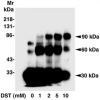The role of proteolytic processing and the stable signal peptide in expression of the Old World arenavirus envelope glycoprotein ectodomain
- PMID: 23218200
- PMCID: PMC3545064
- DOI: 10.1016/j.virol.2012.10.038
The role of proteolytic processing and the stable signal peptide in expression of the Old World arenavirus envelope glycoprotein ectodomain
Abstract
Maturation of the arenavirus GP precursor (GPC) involves proteolytic processing by cellular signal peptidase and the proprotein convertase subtilisin kexin isozyme 1 (SKI-1)/site 1 protease (S1P), yielding a tripartite complex comprised of a stable signal peptide (SSP), the receptor-binding GP1, and the fusion-active transmembrane GP2. Here we investigated the roles of SKI-1/S1P processing and SSP in the biosynthesis of the recombinant GP ectodomains of lymphocytic choriomeningitis virus (LCMV) and Lassa virus (LASV). When expressed in mammalian cells, the LCMV and LASV GP ectodomains underwent processing by SKI-1/S1P, followed by dissociation of GP1 from GP2. The GP2 ectodomain spontaneously formed trimers as revealed by chemical cross-linking. The endogenous SSP, known to be crucial for maturation and transport of full-length arenavirus GPC was dispensable for processing and secretion of the soluble GP ectodomain, suggesting a specific role of SSP in the stable prefusion conformation and transport of full-length GPC.
Copyright © 2012 Elsevier Inc. All rights reserved.
Figures





Similar articles
-
Molecular characterization of the processing of arenavirus envelope glycoprotein precursors by subtilisin kexin isozyme-1/site-1 protease.J Virol. 2012 May;86(9):4935-46. doi: 10.1128/JVI.00024-12. Epub 2012 Feb 22. J Virol. 2012. PMID: 22357276 Free PMC article.
-
Assays to Assess Arenaviral Glycoprotein Function.Methods Mol Biol. 2018;1604:169-178. doi: 10.1007/978-1-4939-6981-4_11. Methods Mol Biol. 2018. PMID: 28986832 Free PMC article.
-
Envelope glycoprotein of arenaviruses.Viruses. 2012 Oct 17;4(10):2162-81. doi: 10.3390/v4102162. Viruses. 2012. PMID: 23202458 Free PMC article. Review.
-
Targeting the proteolytic processing of the viral glycoprotein precursor is a promising novel antiviral strategy against arenaviruses.J Virol. 2010 Jan;84(1):573-84. doi: 10.1128/JVI.01697-09. J Virol. 2010. PMID: 19846507 Free PMC article.
-
Lassa virus glycoprotein: stopping a moving target.Curr Opin Virol. 2018 Aug;31:52-58. doi: 10.1016/j.coviro.2018.05.002. Epub 2018 May 26. Curr Opin Virol. 2018. PMID: 29843991 Free PMC article. Review.
Cited by
-
Acidic pH Triggers Lipid Mixing Mediated by Lassa Virus GP.Viruses. 2020 Jul 2;12(7):716. doi: 10.3390/v12070716. Viruses. 2020. PMID: 32630688 Free PMC article.
-
Design, Synthesis, and Biological Evaluation of Benzimidazole Derivatives as Potential Lassa Virus Inhibitors.Molecules. 2023 Feb 7;28(4):1579. doi: 10.3390/molecules28041579. Molecules. 2023. PMID: 36838567 Free PMC article.
-
Identification of a clinical compound losmapimod that blocks Lassa virus entry.Antiviral Res. 2019 Jul;167:68-77. doi: 10.1016/j.antiviral.2019.03.014. Epub 2019 Apr 4. Antiviral Res. 2019. PMID: 30953674 Free PMC article.
-
A validated and standardized pseudotyped microneutralization assay as a safe and powerful tool to measure LASSA virus neutralising antibodies for vaccine development and comparison.F1000Res. 2024 Oct 14;13:534. doi: 10.12688/f1000research.149578.2. eCollection 2024. F1000Res. 2024. PMID: 39512237 Free PMC article.
-
Hemorrhagic Fever-Causing Arenaviruses: Lethal Pathogens and Potent Immune Suppressors.Front Immunol. 2019 Mar 13;10:372. doi: 10.3389/fimmu.2019.00372. eCollection 2019. Front Immunol. 2019. PMID: 30918506 Free PMC article. Review.
References
-
- Bonthius DJ, Nichols B, Harb H, Mahoney J, Karacay B. Lymphocytic choriomeningitis virus infection of the developing brain: critical role of host age. Ann Neurol. 2007;62(4):356–74. - PubMed
Publication types
MeSH terms
Substances
Grants and funding
LinkOut - more resources
Full Text Sources
Other Literature Sources

